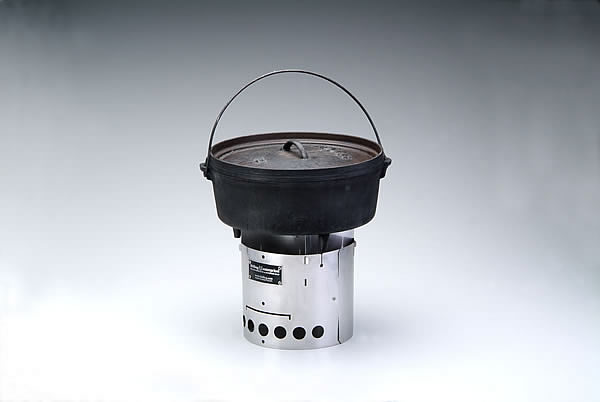Bushbuddy and Littlbug Wood Stoves
Two wood-burning camping stoves. Both are designed to be light-weight and burn small bits of wood to cook food on the trail. No carried fuel, and unlike the Sierra Zip stove, no battery-driven fan. These may not be good for use in areas where woody debris is so picked-over as to be an ecological problem (I’m thinking parts of the Appalachian Trail, most hiking areas in Southern Ontario), but in lower-human-impact zones they will use far, far less wood than an actual fire. Here’s a post from a ranger claiming he doesn’t object to people using them in no-fire zones.
Both of these stoves are products of the thriving and innovative small-manufacturer direct-sales camping gear scene.
Bushbuddy

Backpackinglight has been selling the Bushbuddy Ultra since BPL editor Ryan Jordan commissioned it for a long-distance arctic hike in 2006. I just figured out that the original Bushbuddy is made and sold in Canada. And, they’ve redesigned the cheaper, more robust, slightly heavier “original” model to be lighter than it was, but still cheaper. So there you go.
The Bushbuddy has a two-wall design to preheat the air supply, which they claim lets it burn “as clean as a candle”, more efficiently, and perhaps most importantly to a westerner, with wetter wood. 6.5oz for the $100CDN redesigned Bushbuddy basic, 5oz for the $120CDN Bushbuddy Ultra. Or, if you’re in the US and know that import duties are high, get it from Backpackinglight for $140USD (a little cheaper if you’re a BPL member).
Update: Fritz from F.H. Enterprises emailed to say that there should be no duty charged going into the U.S. and to point out that at the exchange rates at time of publication, that makes for about $79USD, including shipping.
Littlbug

If the Bushbuddy is too high-tech for you, the Littlbug is a similar thing with an even less engineeered design. Comparable weight, plus it breaks down and nests (in a good way). Not dual-wall, so perhaps that effects performance. Appears a little more durable, and they’re substantially cheaper. $60USD for the 5.1oz “junior”, and there’s a 16oz “senior” for the youth-group community for about the same price. Note however that the Bushbuddy has a closed bottom to reduce scarring, and the Littlbug would need the 9oz/$25USD firepan for the same function. Note also that the firepan comes bundled with a hanging chain, in case you want to have a suspended “self-centering” fireplace, or you could buy two for campsite poi twirling.
Boil times:
According to their respective websites, the Bushbuddy will boil 1 liter of water in 8-10 minutes, and the Littlbug Jr. will take 4-6 minutes for the same operation (they use American water, which only comes in quarts, but it’s very similar). Interesting, although a side by side comparison controlling for ambient and water temperatures, altitude, wood type and fire making technique might yield different results either way.
Gearshed Analysis:
If you’re concerned about the energy your stove will consume in reaching you, and concomitant climate-altering carbon emissions, I have prepared a rough map of the gearshed boundary of the two devices. The Bushbuddy is made in Iskut (!) BC by Fritz, the Littlbug comes from Kent and the individuals with disabilities he employees in Bemidji Minnesota.
Note that this is only a first-order analysis, and does not account for road networks or flight paths, border effects, idling times, switching costs, or aesthetic factors. You may wish to conduct your own analysis. Note also that if you buy the Bushbuddy from Backpackinglight, it will be traveling twice. Note also also that the closer to the line you are, the less it really matters. Not that Calgarians would care, anyway.
View Gearshed: Bushbuddy v. Littlbug stoves in a larger map
(If that line looks a little off-center, it’s probably because Google Maps displays in a Mercator projection, which isn’t so hot for area-distance relationships.)
This is not a review: I have not used either of these stoves (I’m still in a love/hate relationship with my alcohol stove). If anyone has first-hand experience they’d like to share, please comment.
Update 2:Kent contacted me and is sending a unit for review, and it turns out that a friend of mine has a Bushbuddy, so once I have both in my hands I’ll make a new post comparing and contrasting the two. Watch this space. And please, leave your own comments!